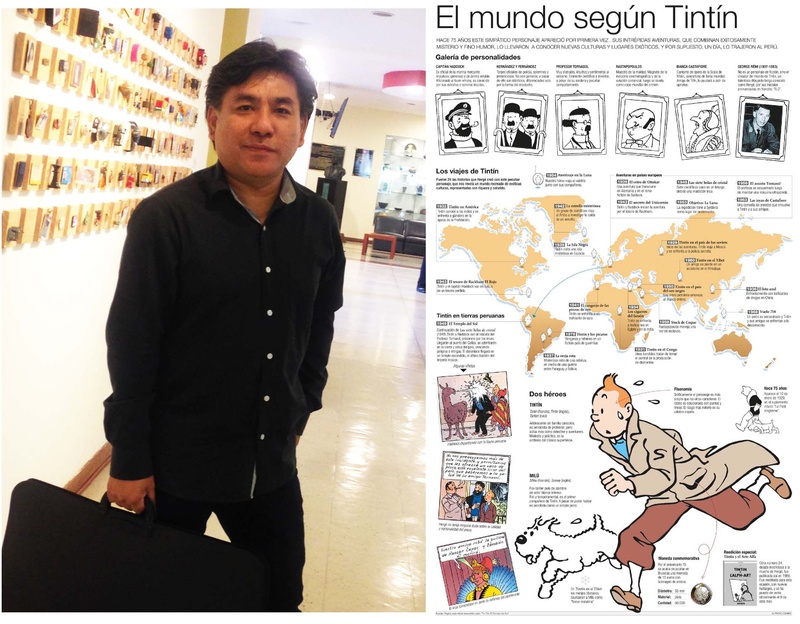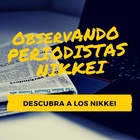Not long ago, journalism was the simplified task of writing and photographing what reporters knew when visiting the scene. Radio and television were the first technological media to transfer the news to their platforms and the press made a great innovation with infographics, which in Peru are less than 30 years old, giving the information the color of the schematic illustration. The newspapers El Sol and El Comercio were the pioneers in this work, which has an artistic side that attracts the attention of the entire public.
Since he was a child, Alfredo Oshiro Fukuhara liked to draw, he wanted to make comics, that's why he entered the art faculty at the Pontifical Catholic University of Peru in 1988, where he chose the specialty of graphic design which, although it was not entirely attractive to him, At least it offered him greater job and economic possibilities. When he was already in the last years of his career, he started working at the newspaper El Sol , which was going through a redesign process.
“I arrived by chance because some friends called me; I had never made infographics or studied it,” says Alfredo, who thought of dedicating himself to it for a while and then continuing to look for other professional experiences. He stayed only one year but it was because greater challenges awaited him at El Comercio , performing the same function that was beginning to gain popularity.
Beginnings of infographics
Oshiro says that in the first years infographics were very basic, they were used above all to illustrate crimes, crimes or kidnappings (the nineties were years in which insecurity and crime skyrocketed in Lima) although with very little journalistic rigor. One of the most notorious cases in those years was the takeover of the residence of the Japanese ambassador in Lima, in 1996, which occurred when Alfredo was barely a month into the newspaper.
“In 1999, Xabier Díaz arrived at El Comercio as an infographic editor with the idea that it would be very precise, that it would not just be to liven up the news. “He recruited many journalists, with different inclinations, to dedicate themselves to infographics,” says Oshiro. They were years in which different journalistic events motivated the creation of important infographics in the main Peruvian newspaper.
Two of those that Alfredo Oshiro remembers most were the explosion of a car bomb in the El Polo shopping center, near the United States embassy, and the fire at the Utopia nightclub, both of which occurred in 2002. Of the first case, he says that He arrived with the newspaper reporters and, while they took notes, he made drawings. In the case of Utopia, he was able to talk to some of the young people who were inside, which helped him to be more exact in the illustrations.
“In the case of El Polo, I was in the newsroom when the attack occurred and when I returned they asked us to publish the note with the infographic, so we decided to make a freehand drawing due to the pressure of time,” says Alfredo, who also remembers that in the Utopia case, the graphics published by El Comercio were used during the trial that took place for the people who died in the accident.

Drawn tradition
When he first arrived at El Sol , Alfredo Oshiro carried with him an encyclopedia that had been published in the eighties called La Combi Visual. It was one of the few reference books I had as a designer. By 2005, when he became head of the infographics area of El Comercio , the newspaper's innovation and participation in the World Summit and the Malofiej International Infographic Awards, in Spain, were very frequent.
The infographic was evolving, reducing the decorative elements to be simpler and more effective. In addition, the team of infographic designers proposed their own themes and was in charge of the research and texts. This is how they won different awards using multimedia resources. Thus, in 2008, the Machu Picchu infographic won the Award for Journalistic Excellence from the Inter-American Press Association (IAPA).
Through it you could take a virtual tour of the main attractions of the citadel that a year earlier had been chosen as one of the New Seven Wonders of the Modern World. Other digital works, such as the infographic on “The Fujimori mega-trial”, “Lake Titicaca in serious ecological risk” and “The clone war”, among others, received the Malofiej prize, considered the Pulitzer of infographics worldwide. .
“We won many awards with cultural, social and political themes,” says Oshiro, who was in charge of the infographics area until 2013, when he decided to become independent, in addition to teaching classes at two Peruvian universities. “Currently infographics are changing, there is a decline in drawing due to new animation techniques, which is why more analytical work has to be done to be more linked to data journalism,” he says.
The nikkei of the combi
Alfredo says that he grew up on the La Taboada farm, an agricultural area located near the Jorge Chávez International Airport. This hacienda, along with others such as San Agustín , were occupied by Nikkeis. He remembers that there was a lot of distance between home and home, that's why he didn't go out much and spent most of his time reading. One of the books he liked the most was the encyclopedia “La combi visual” which, in addition to being a bedside book, served as inspiration for a collective project.

“In 2007, the infographic artists of the El Comercio group created La Combi Gráfica , to promote the characteristics of infographics as a discipline of visual communication.” Since then, together with friends and colleagues such as Antonio Tarazona, Martín Arias and Carmen Gallegos, they have held exhibitions of their most notable works of the last 20 years. The most notable was Generación infographic , which was presented in 2018 at the Peruvian Japanese Cultural Center.
“The language of infographics is not only for the press, it is used to study any subject in which the graphic and written approach is used,” explains Alfredo, who has also done work for the Museum of Japanese Immigration to Peru and for various publications. , many of them from the community and, although the Japanese traditions that he had in his childhood, such as butsudan and having studied in a Japanese school, are not so present today, he has known a large part of the history of immigration for his research.
“I am not very aware of the Japanese influence in my work,” says Alfredo who, despite a very oriental modesty, has become a reference in Peru within this specialty where minimalism in design (something also very oriental) and rigor (of the same origin) are fundamental to creating illustrated journalism that not only follows the graphic meaning but also the intellectual one.

© 2019 Javier García Wong-Kit







